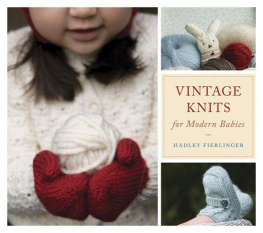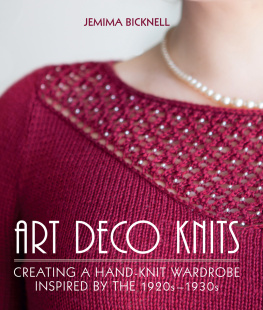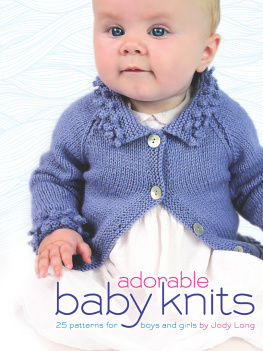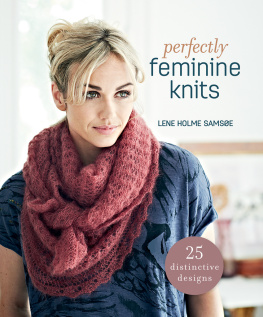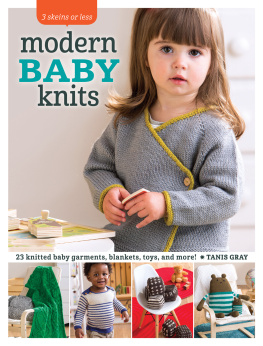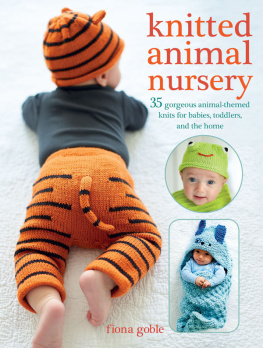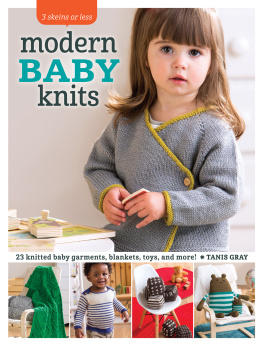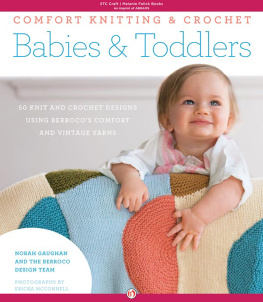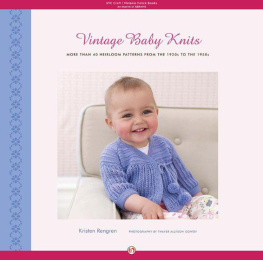Copyright 2009 by Hadley Fierlinger
Photographs copyright 2009 by Angela Lang
All rights reserved.
Published in the United States by Ten Speed Press, an imprint of the Crown Publishing Group, a division of Random House, Inc., New York.
www.crownpublishing.com
www.tenspeed.com
Ten Speed Press and the Ten Speed Press colophon are
registered trademarks of Random House, Inc.
Illustrations by Tannya Harricks.
Used with permission.
The , Nicky Epstein, is reprinted
from Nicky Epstiens Knitted Flowers with permission from the author and Sixth&Spring Books.
Library of Congress Cataloging-in-Publication Data
Fierlinger, Hadley.
Vintage knits for modern babies / Hadley Fierlinger.
p. cm.
Includes index.
Summary: A collection of 25 knitting patterns for baby and toddler clothing
and accessories, based on vintage designsProvided by publisher.
1. KnittingPatterns. 2. Infants clothing. 3. Infants supplies. I. Title.
TT825.F554 2009
746.432041dc22
2009008446
eISBN: 978-1-60774-126-8
v3.1

For Grammy and Marion, who are forever in my heart


Contents

Acknowledgments
This book was made possible by the people close to me and some who are very far away.
First I would like to thank good friend Heidi Swanson, who made the book a possibility, along with Julie Bennett at Ten Speed Press, who helped me form the idea. Thank you to my wonderful editor, Brie Mazurek, who made the process easy and stress free. Thanks also to designer Katy Brown for these beautiful pages.
I have a great deal of thanks to my mom and dad, who have supported everything I have done and helped me grow into who I am today.
Deepest thanks to Jo Reeve, my savior, who kindly helped me with pattern making when I was stuck.
Many thanks to Pauline the knitter, who deserves her name on the cover for quickly knitting everything in this book (and much more).
Thanks to my Wellington stitch-n-bitch posse; Lesleigh, Kristy, Merryn, Sally, Tannya, Virginia, and Wanda. A special thank you to the amazing seamstress Lesleigh, who made some of the dresses that appear in the photographs.
Thanks to Angela Lang and her family for her beautiful photographs. I would also like to thank the child models and their families: Aidan Mogal, Josh Mogal, and Katy Haberkern; Camila; Camille, Rebecca, and Victor Amato; Griffen; Madhavi Kennedy, Craig Kennedy, and Urmila Raghavan; Milan, Wonny, and Joe Mullen; Rowan, Alana, and Zach Thompson; Simon, Kristen, and Jim Policy; and Ella, Julie, and Rodney Walker.
Thank you to Tannya Harricks, who did the illustrations in the book and has always been my partner in crime when it comes to project ideas and inspiration.
Finally, and most important, I am the luckiest woman alive to spend every day of my life with three of the most gorgeous boys I have ever known; thanks Philip, Emory, and Jasper for supporting all my work and letting me have my time and space to be a girl in a house of boys.

Introduction
Most of us knit for babies today because we want to, not because we have to. We knit for them, as our grandmothers did, for the love of it. We knit because nothing else can give us the same soothing texture and emotion as a garment created by hand. While we sit and knit, our hopes and dreams are wrapped in every stitch.
Few things are more scrumptious than the cozy warmth of a new baby swaddled in a lovingly hand-knit blanket. We can practically smell the heavenly scent of that loved and worn blanket nestled under the chin of its tiny owner.
My passion for baby knits was born years ago when I met my friends new baby, Anya. She was wearing a beautiful tiny white eyelet cardigan that had been expertly hand knit. When I asked Anyas mother where she bought it, she explained that her own grandmother had knit it for her back in the 1960s. She had worn it as a baby, and she had saved it for her future babies. The cardigan Anya wore was in perfect condition, not a stain or pulled thread, after all those years. Every time I saw Anya after that, she wore a different vintage cardigan layered over a simple white T-shirt, just as her mother had more than thirty years earlier. It is a timeless style that captures the simplicity of babyhoodcozy, comfortable, practical, and sweet.
Inspired by Anyas sweaters, I promised myself that I would learn to knit, so one day I could create my own beautiful heirlooms for my children and grandchildren. With my newfound knitting passion, I launched Shescraftyknits.com in 2002, selling my own designs of hand knit baby wear. Over the years, I have designed knitting patterns that capture vintage style and meet modern necessityless-complicated, updated classics that hark back to simpler days.
Heirlooms from Generations Past
Many of us have a baby keepsake box in which our mothers kept treasured mementos from our first year. If there was a knitter in your family, your keepsake box most likely contains a pair of tiny booties recording the brief moment when your feet were no bigger than a dolls. Perhaps you recall poking your toes through the holes of an afghan that always adorned the family sofa. These family heirlooms are treasures created to give warmth to the wearer and tactile memories that last a lifetime. If you are lucky, you may have a whole box of baby knits lovingly saved to pass down to your own children and grandchildren so you can continue the tradition.
Generations ago, knitting was an important skill that every girl needed to learn from an early age. In the beginning of the twentieth century, no shops sold layettes (complete outfits for newborn infants) or diapers, and knitters in the family had to create everything a baby was going to need for the first year (and beyond). Before published knitting patterns became available, knitters used jotted-down recipes with guides on the general shape and size of a garment to be knit. The recipes were shared within the family and community to create practical garments such as socks, underwear, stockings, and baby clothes. Families knew the importance of thrift as well as the practicality of wool, which was the primary knitting yarn.
Early knitting pattern books started to appear in the late 1800s and were filled with very sensible everyday items for the whole family. In the early 1900s few women could afford to buy a ready-made baby layette, which was only available to the very wealthy, so everything was knit at home. To prepare for a new baby, most mothers created layette items months in advance. A lucky family would have an aunt or a grandmother busily knitting to help fill babys clothes drawers with fancy dresses, gowns, coats, and frilly bonnets for outings and celebrations. Babies mostly required simple items such as wool soakers, rompers, vests, blankets, leggings, and plenty of caps and booties. The most popular knitting patterns were designed with simplicity and thrift in mind. Usually they were made on very skinny needles with thin baby yarn, which took quite a while to knit and produced very delicate garments.

